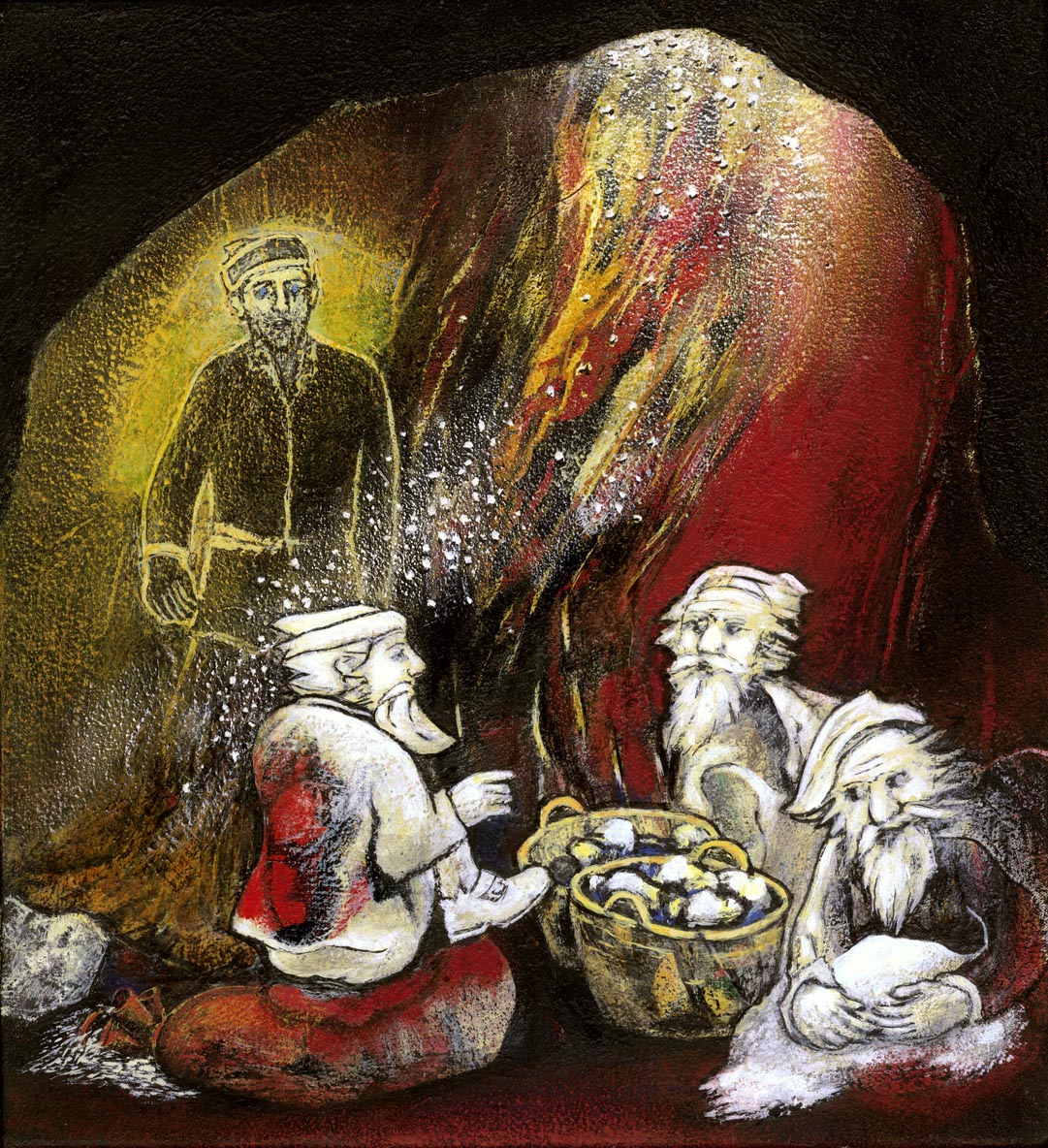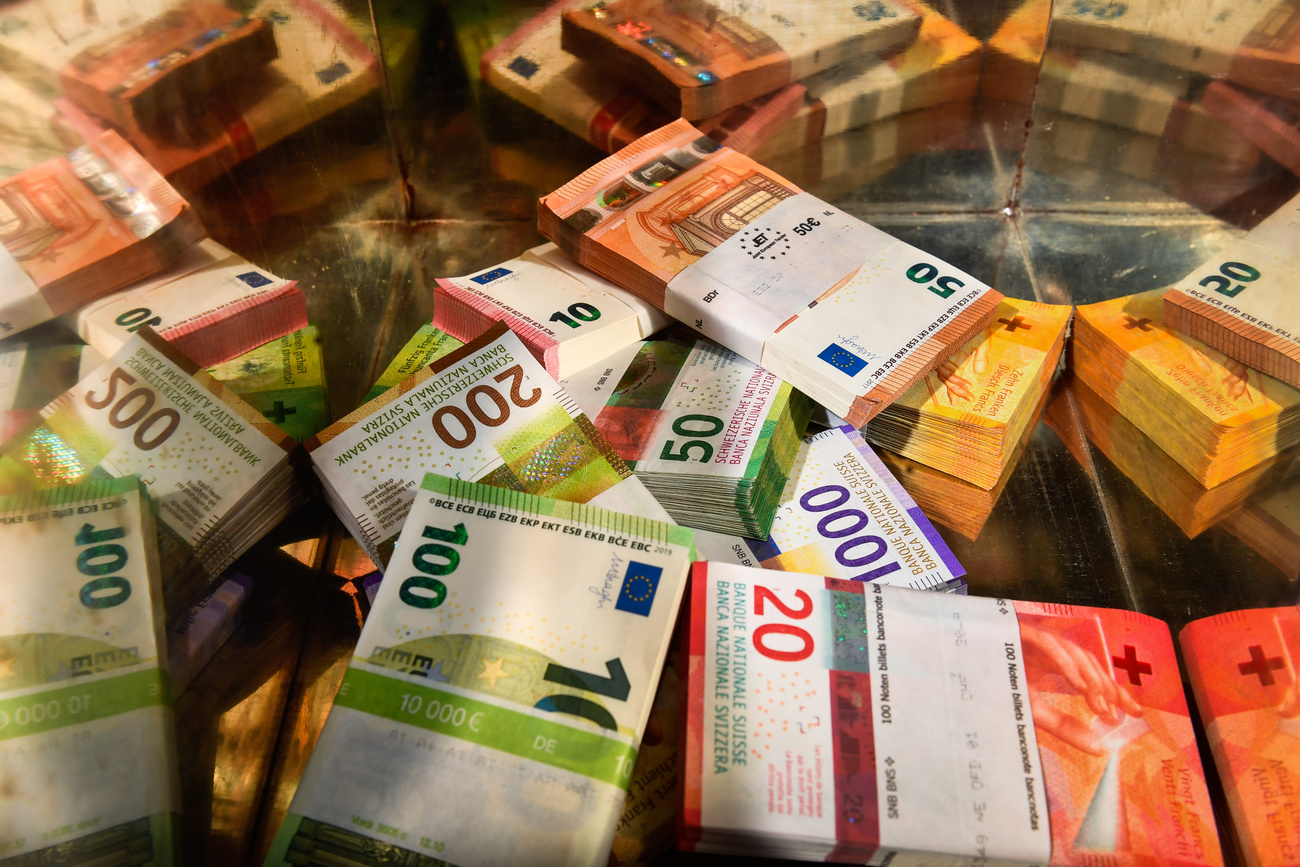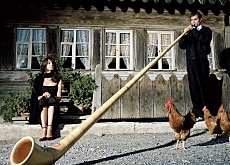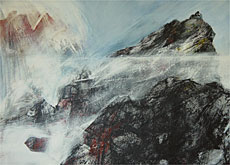On a mythical journey under the Alps

The metal doors of the tiny passenger train slam shut and our mythical voyage begins as we descend deep beneath the salt-rich Alps near Bex in western Switzerland.
“I like exhibiting in places that are not necessarily typical galleries,” explains Swiss-Australian artist Lucienne Fontannaz, whose new exhibition on Swiss myths recently opened at the historical – and still operational – Bex Salt Mines.
After 15 minutes the train grinds to a halt at the entrance to a large open cavern, which also serves as a restaurant and art gallery for the popular salt mine that pulls in some 70,000 visitors annually.
After many years spent abroad, Fontannaz, who currently lives in Sydney, Australia, cannot hide her excitement at showing off her paintings on historical myths of the Vaud Alps deep beneath her native soil.
“I was born in Bex and many generations of my family lived here,” she told swissinfo.ch. “Every time I come back it stirs me like nowhere else in the world.”
For the past ten years, her work has focused on her memories of the Swiss Alps, local legends and stories by early travellers to Switzerland.
At the centre of her new exhibition in two parts, La légende de Jean du Bouillet, and Alpes Vaudoises – nos légendes, are more than 40 oil paintings on century-old local alpine myths.
The Jean du Bouillet tale, which was originally written by local historian Alfred Cérésole in 1885, re-tells the legend of the discovery of salt at Bex.
In the series of oil paintings, we see the local farmer chancing upon a cave of gnomes attacking rock faces with their tiny picks. The rubble is then crushed into minute pieces and boiled up to release a crystalline substance.
Du Bouillet later returns home and tries to convince the local villagers about what he saw and that there is “gold” beneath their feet.
White gold
Nowadays, salt is universal but centuries ago the Swiss, with no salt production of their own, depended on huge quantities from all over Europe for cheese-making, salting butter and cattle, as well as for tanning skins and preserving meat, fish and vegetables.
“Having your own salt and being able to sell it was an enormous advantage,” said Fontannaz.
Salt springs were originally discovered above Bex in the 15th century. The Bernese exploited them via evaporation techniques for the next 200 years until the first excavation work began in 1684.
Today, the local miners still unearth 100 tonnes of salt a day, almost 70 per cent of which is used on the Vaud roads in winter. But they also produce a range of table salts and exotic bath products.
“It’s an ongoing happy story. The people who work in the mine are very proud of this place and its history,” she said.
Moral tales
The second half of the exhibition – Alpes Vaudoises – nos légendes – continues on the opposite site of the huge cave.
The paintings bring to life 20 myths selected from Cérésole’s popular book, Légendes des Alpes Vaudoises, which was written in 1885 but continues to be published to this day.
Cérésole hunted down and transcribed fables before they were forgotten and replaced by new ideas and stories imported by globe-trotters.
His myths were always closely linked to the landscape, describing the inspirational but tough living conditions in the mountains. Some of the tales also have a strong ecological slant, such as the Gargantua or the Kandinsky-esque series on the “L’age d’or” [Golden Age], which describes green and plentiful pastures which become barren through greediness.
“There was lots of morality in the tales,” said Fontannaz. “But we can see how educational they were, told at night as a diversion at the end of a hard day. Very often we thought legends were for children, but often they told about adults’ lives and fears, and were of interest to everyone.”
Handed down from generation to generation, many of the fables were believed to be true and had a powerful influence on those listening.
Supernatural beings
The forces of nature were personified into either protective or demonic characters, interacting with the mountain people in all aspects of their daily lives. These supernatural beings took on many forms: mountain spirits, good fairies, giants, dragons, devils, demons, sorcerers and ghosts.
“I’m amazed at how many of them compare with Aboriginal stories,” said the Swiss-Australian painter. “Aboriginals are very attached to the places where they were born, to their landscape, language, stories and traditions. I’m sure it was much the same here in the early days.”
The origins of these ancient stories are manifold. Some came directly from life in the Alps; others could be traced back to Roman customs, to Druid or Celtic pagan ceremonies, even to the myths from India and the East, whilst others were influenced by Saracen, Germanic and Gallic cultures.
The spread of Christianity also had a major impact on the telling of ancient tales.
“Some were created during the rise in Christianity or were adopted from old pagan legends to make them more palatable,” she explained.
Fontannaz, who has already organised an exhibition on myths from the nearby Gruyere region and plans to next look at the Valais region, believes there is a mythology revival in Switzerland.
In Gruyere her talks on local myths, each with a specific geographical location, were turned into a tourist walk and her regular storytelling evening still continues to his day.
“We were brought up with legends from Egyptian or Indian cultures but there has been a resurgence of interest in local stories recently.
“I think people appreciate looking back at their roots and seeing how people understood the world,” she said.
Simon Bradley in Bex, swissinfo.ch
The exhibition Alpes Vaudoises nos légendes and La légende de Jean du Bouillet – the Bex Salt Mines, runs until December 21, 2010 at the Taverne du Dessaloir, located inside the Bex Salt Mines in western Switzerland.
At the centre of the exhibition are more than 40 paintings on local myths by Swiss-Australian artist Lucienne Fontannaz, who was born in Bex but now lives in Sydney, Australia.
Her work has been exhibited in various museums and galleries in Switzerland.
The paintings from the exhibition feature in two books Alpes vaudoises – nos légendes, 2007 (in French, English, German and Italian) and La légende de Jean du Bouillet – mines de sel de Bex, 2010 (in French and English).

In compliance with the JTI standards
More: SWI swissinfo.ch certified by the Journalism Trust Initiative














You can find an overview of ongoing debates with our journalists here . Please join us!
If you want to start a conversation about a topic raised in this article or want to report factual errors, email us at english@swissinfo.ch.